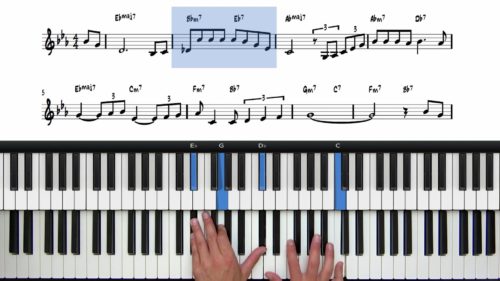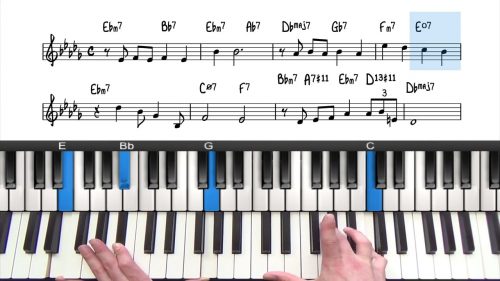The Backdoor 2-5-1 Progression
Welcome to this lesson on the backdoor 2-5-1 progression. We focus on how to incorporate this useful chord substitution in bar 6 of the 12 bar blues progression. We break down how the backdoor 2-5-1 works and how to integrate it seamlessly into our blues piano playing.
By the end of this lesson, you’ll understand not only the theory behind the backdoor 2-5-1 but also how it appears in different contexts such as popular jazz standards like Misty, Over the Rainbow, and Tenderly.
What is the Backdoor 2-5-1?
The backdoor 2-5-1 is an alternative resolution in jazz harmony, often used to create a more unexpected cadence. Unlike the traditional 2-5-1 progression in C major, which goes from D-7 (ii) to G7 (V) to Cmaj7 (I), the backdoor 2-5-1 substitutes the G7 with a dominant chord built off the flat 7th of the key.
For example, in the key of C major, the backdoor 2-5-1 would involve:
- 2 chord: F-9
- 5 chord: Bb7 (the dominant built on the flat 7th of the key)
- 1 chord: Cmaj7
Notice that we also substitute the ii-7 chord for the related ii-7 chord of Bb7.
Understanding Dominant Flat 9 Chords
To fully grasp the backdoor 2-5-1, it’s essential to explore how dominant b9 chords function and their relationship with diminished harmony. These chords can be built off multiple roots and are interchangeable due to their relationship within the diminished scale.
For instance, a rootless G7b9 chord shares the same notes as a rootless Db7b9, Bb7b9, and E7b9 making these chords functionally equivalent. This relationship allows us to substitute dominant chords in our chord progression creating more interesting and unexpected cadences and resolutions.
Applying the Backdoor 2-5-1 in Jazz Standards
Many jazz standards feature the backdoor 2-5-1 or similar iv- chord progressions. For example, in Misty, the tune moves from the 4 chord (Abmaj7) to a 4 minor (Ab-) before resolving back to the tonic (Ebmaj7). This mirrors the backdoor 2-5-1 movement that can be applied in the 12 bar blues, only now we are in the key of C Major.
Other songs like Over the Rainbow, There Will Never Be Another You, and Tenderly also incorporate this harmonic device which is used to create a smooth and unexpected resolution to the tonic.
Exploring the 4 Minor Substitution
The 4 minor substitution is closely related to the backdoor 2-5-1. In C major, the 4 chord is Fmaj7, which can turn into F-7 before moving to its V7 chord Bb7 and finally resolving to Cmaj7. An interesting variation is to play F-6 which is effectively a Bb7 chord with an F in the bass.
This technique is particularly effective in the slow 12 bar blues as it provides a fresh harmonic twist in bars 5 & 6 of the 12-bar blues form.
Putting It All Together
As you incorporate these ideas into your playing, focus on the connections between diminished chords and dominant b9 chords. Understanding these relationships allows you to move confidently between different harmonic options.
In the next lesson, we will shift our attention to the first four bars of the blues, exploring some New Orleans-style voicings and additional 2-5 progressions that can enhance our blues performances.
Practice Tips
-
Diminished Chords: Visualise how each diminished chord links 4 different dominant b9 chords.
-
Jazz Standards: Analyse the backdoor 2-5-1s in jazz standards like Misty or Over the Rainbow to see how this device is used in the jazz standard repertoire.
- Incorporate into the Blues: Focus on bars 5 and 6 of a 12-bar blues, substituting a full backdoor 2-5-1 or just a iv-6 chord to add harmonic sophistication and an interesting transition from F7 back to C in bar 7.







Hi Hayden,
You speak often of the improv modual? Where can I find it ?
Thanks.
Best regards
Véronique
Hi Véronique,
I did not add the improvisation module yet – but it is on my to-do-list.
We will cover some improvisation principles in my blues workshop today, you can watch the seminar live here: pianogroove.com/live-seminars/slow-blues-piano-workshop/ – and the replay will be available tomorrow.
I’m aiming to get the improvisation module for this course finished asap.
Best,
Hayden
Merci pour ta réponse Hayden et je me réjouis de découvrir ce nouveau module et aussi le workshop.
Belle suite.
Bien à tu
Véronique